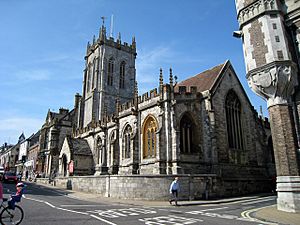St Peter's Church, Dorchester facts for kids
Quick facts for kids St Peter's Church |
|
|---|---|

St Peter's Church
|
|
| Religion | |
| Affiliation | Church of England |
| Ecclesiastical or organizational status | Active |
| Location | |
| Location | Dorchester, Dorset, England |
| Architecture | |
| Architectural type | Church |
St Peter's Church is an old and important Church of England church. It is located in Dorchester, Dorset, England. Most of the church was built in the 1400s. Over the years, it has been changed and made bigger. Since 1950, it has been a special "Grade I listed building". This means it is a very important historical building.
Contents
History of St Peter's Church
St Peter's Church is built from special types of stone. These are called Portland and Ham stone. The roofs are made of slate, tile, and lead. The oldest part of the church is the south doorway. This part dates back to the 1100s. It shows that an earlier Norman church once stood here. Most of the building was constructed around 1420. This includes the tall west tower, the main part (nave), and the side sections (north and south aisles). It also includes the chancel and the south porch. North and south chapels were added later in the 1400s.
Church Renovations in the 1800s
From 1855 to 1856, the church was repaired and updated. This work included rebuilding the east side of the church. A new room called the north vestry was also added. The gallery at the west end was taken away. The organ was moved to the north aisle. The old wooden benches were replaced with new open seats. The reading pews were changed to a reading desk and a lectern made of oak wood.
The person in charge of this work was John Hicks from Dorchester. He was an architect. A famous writer named Thomas Hardy was one of his students. The builder for the project was John Wellspring. He was from West Fordington. The work started in August 1855. The church reopened for services on July 10, 1856. While the church was closed, services were held in Dorchester's town hall.
Later Changes and Special Features
The church was updated again in the 1900s. This happened in 1905, 1934, and between 1961 and 1965. The chancel area was refurnished from 1894 to 1897.
Inside the church, there are some interesting old features.
- In the south chapel, there are two stone figures from the 1300s. They show knights lying down.
- The chancel has a tomb chest from the 1300s.
- In the north chapel, there is a large stone coffin from the early 1600s. It belongs to Sir John and Lady Williams. They were from Winterborne Herringston.
- The north aisle has a monument from the late 1600s. It includes a figure of Denzil Holles.
- The reredos in the chancel was made by Charles Ponting. This was done between 1894 and 1897. A reredos is a decorated screen behind the altar.
Gordon Memorial Plaque
From 1774 until 2023, the church had a special plaque. It was a memorial for John Gordon. He was a plantation owner in the 1700s. He was involved in stopping a slave rebellion in Jamaica. This rebellion was called Tacky's War.
Over time, people started to criticize the words on the plaque. In 2020, the church's council decided to remove it. The plaque was taken down on May 19, 2023. It was then loaned to the Dorset Museum. A new plaque will be put in its place in the future. This new plaque will not mention the rebellion.

